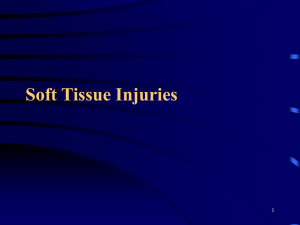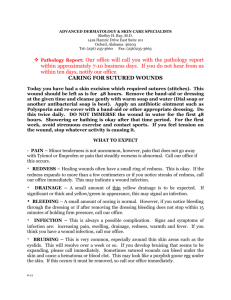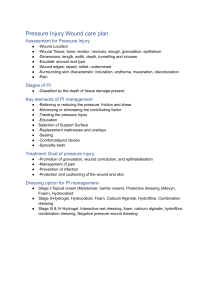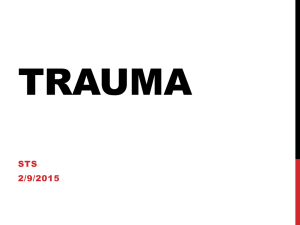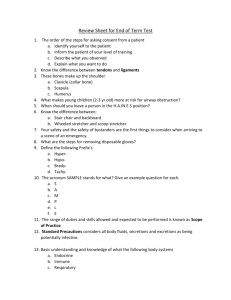Soft Tissue Injuries
advertisement
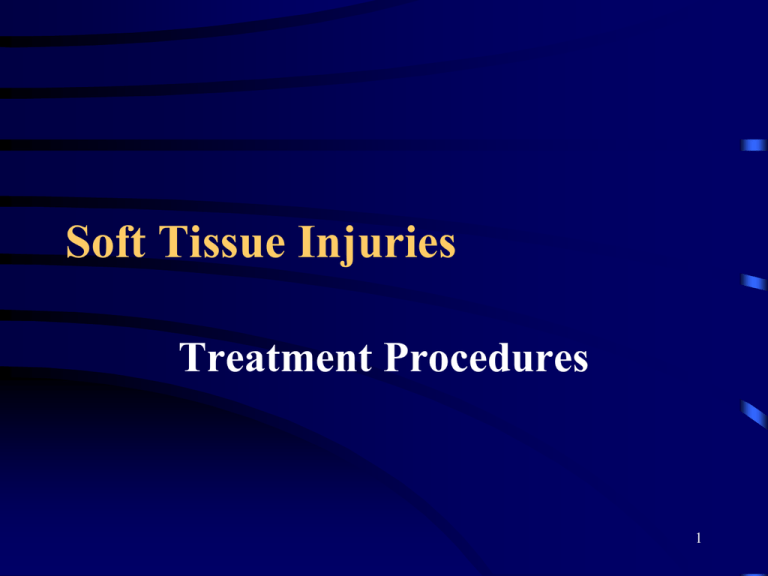
Soft Tissue Injuries Treatment Procedures 1 Skin Anatomy and Physiology • Body’s largest organ • Three layers – Epidermis – Dermis – Subcutaneous tissue 2 Skin Anatomy and Physiology • Complex system, variety of functions – Sensation – Control of water loss – Protection against microbes – Temperature control 3 Soft Tissue Injuries • Closed • Open 4 Closed Injury • • • • Associated with blunt trauma Skin remains intact Damage occurs below surface Types – Contusions – Hematomas 5 Contusion • Produced when blunt force damages dermal structures • Blood, fluid leak into damage area causing swelling, pain • Presence of blood causes skin discoloration called ecchymosis (bruise) 6 Hematoma • “Blood lump” • Larger blood vessel damaged • Causes mass of blood to collect in the injured area • Fist-sized hematoma = 10% volume loss 7 With Closed Soft Tissue Injury • How much blood is tied up in that injury rather than circulating in the vessels? • What could the force the caused the soft tissue trauma have done to underlying organs? 8 Closed Injury Management • • • • • Rest Ice Compression Elevate Splint When in doubt assume underlying fractures are present 9 Open Injury • Skin broken • Protective function lost • External bleeding, infection become problems 10 Open Injury Types • • • • • Abrasions Lacerations Punctures Avulsions Amputations 11 Abrasion • Loss of portions of epidermis, upper dermis by rubbing or scraping force. • Usually associated with capillary oozing, leaking of fluid • “Road rash” 12 Laceration • Cut by sharp object • Typically longer than it is deep • May be associated with severe blood loss, damage to underlying tissues • Types – Linear – Stellate 13 Punctures • • • • Result from stabbing force Wound is deeper than it is long Difficult to assess injury extent Object producing puncture may remain impaled in wound 14 Avulsions • Piece of skin torn loose as a flap or completely torn from body • Result from accidents with machinery and motor vehicles • Replace flap into normal position before bandaging • Treat completely avulsed tissue like amputated part 15 Amputations • Disruption of continuity of extremity or other body part • Part should be wrapped in sterile gauze, placed in plastic bag, transported on top of cold pack • Do NOT pack part directly in ice • Do NOT let part freeze 16 Open Wound Management • Manage ABCs first • Control bleeding • Prevent further contamination, but do not worry about trying to clean wound • Immobilize injured part • Mange hypoperfusion if present 17 Special Considerations • • • • • Impaled objects Eviscerations Open chest wounds Neck wounds Gunshot wounds 18 Impaled Objects • Do NOT remove • Stabilize in place • Exception – Object in cheek – Remove, dress inside and outside mouth 19 Eviscerations • Internal organs exposed through wound • Cover organs with large moistened dressing, then with aluminum foil or dry multi-trauma dressing • Do NOT use individual 4 x 4’s • Do NOT attempt to replace organs 20 Open Chest Wound • May prevent adequate ventilation • Cover with occlusive dressing • Monitor patient for signs of air becoming trapped under pressure in chest (tension pneumothorax) • If tension pneumo develops lift dressing corner to relieve pressure 21 Neck Wounds • Risk of severe bleeding from large vessels • Risk of air entering vein and moving through heart to lungs • Cover with occlusive dressing • Do NOT occlude airway or blood flow to brain • Suspect presence of spinal injury 22 Gunshot Wound • Special type of puncture wound • Transmitted energy can cause injury remote from bullet track • Bullets change direction, tumble • Impossible to assess severity in field or ER • Patient must go to OR 23
